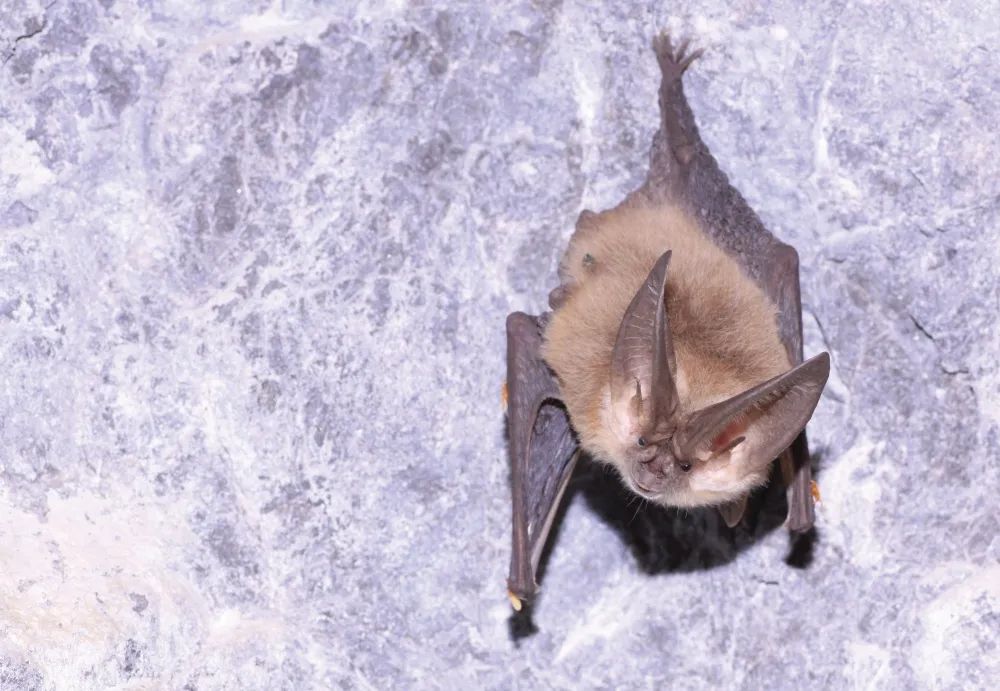
Bats: Better Than You Think
October 2021
by stephanie hobby | Photo of Townsend's Big-eared Bat courtesy of Tom Forwood of Lewis & Clark Caverns
Halloween decorations are starting to go up, and bats are seemingly everywhere. But don't be fooled - the real ones are increasingly tough to spot this time of year. As the air starts to chill, bats make their way to their winter homes, nestling in for winter hibernation. And while it's tempting to align them with all things creepy, the reality is they are more closely tied to your Halloween treats.
Without bats, there would be no chocolate! As the primary pollinators of the cacao plant, bats play an essential role in our ecosystem. We also have bats to thank for peaches, bananas, avocados, and agave plants. Still not convinced that having bats around is more treat than trick? Consider this: a single bat can eat hundreds of harmful bugs like mosquitoes every day and help keep other pests at bay.
With so many misconceptions about bats, advocates have launched numerous educational campaigns. One popular local outreach is the Montana Audubon Center’s nighttime bat hikes, guided by Megan O’Reilly, a wildlife biologist with Montana Fish, Wildlife and Parks. O’Reilly starts the evenings with a talk to dispel bat myths. “A lot of people have the idea that they’re very similar to mice. They think of them like vermin, but they’re very long-lived, and typically have one pup per year,” O’Reilly said. “I think folks think that they reproduce really quickly, and they don’t.”
Other concerns she has put to rest include bats' susceptibility to carrying rabies, getting stuck in people's hair, and that they are blind. None of those are quite true. While bats can carry rabies, it's pretty rare, and O'Reilly is quick to point out that they only test the sick bats, so it might seem like a lot of bats are sick. Bats can also see about as well as we can. Combined with their incredible echolocation abilities, they rarely crash into things, including scalps. "Bats don't want to get tangled in your hair any more than you want them to," O'Reilly joked.
Assistant manager of Lewis and Clark Caverns Tom Forwood says the best way to spot bats is to visit a body of water, preferably a pond, after dark. Insects congregate around water, where bats can find an easy feast. If you go with O’Reilly, she lends ultrasonic devices to help participants hear their movements. “It’s really fun, because you can actually hear them flying overhead,” she said.
Here in Montana, there are 15 species of bats, which is a tiny fraction of the roughly 10,000 species worldwide. However, a really special bat colony lives at the Lewis and Clark Caverns. Relatively hard to find, the Townsend big-eared bat colonies are typically very small, and the Caverns are home to one of the larger populations in the state. It's also a maternity colony, where mother bats give birth and raise babies. (As an aside, bat moms are incredible. Using their unparalleled hearing, a mother bat can distinguish the cry of her own baby, even among a colony of hundreds of thousands!)
According to Forwood, it takes around six weeks for bats to learn to fly, and once they've got their aerial techniques down, it's time to move to their winter shelters. Some stick around to hibernate in the caves, but others leave, and no one knows for sure where they go. “Caves get the spotlight. That connection is kind of romantic, but most of them really prefer old dead trees or to live under the bark in hollows,” Forwood said. “Older buildings replicate that, and are better roosts for most of our species.” He added that the largest bat colony in the vicinity is actually a Little Brown Bat maternity colony in an old maintenance shop.
So far, the Townsend Big-Eared bats at the Park have avoided the dreaded White Nose Syndrome, a fungal illness that has killed millions of bats nationwide. “It's kind of a ‘when not if’ sort of thing. The good news is that Townsend Big-Eared bats seem to be pretty resistant to it. They’re more a vector where they'll actually bring it from population to population, but they don't get hammered by it. There are very few white nose deaths attributed to that species,” Forwood said. “But the other bats in the park, like the Little Browns and other Myotis, as well as Big Brown Bats, that also utilize the Cave, would be very susceptible to it.”
Human homes are also a threat to bats. O'Reilly said if you have bats living in your attic, try to avoid calling an exterminator between May and September, when they are roosting and nursing pups. The only way to completely rid your house of a bat colony is to keep them out, so make sure they've all left for the winter before you seal up those openings. "If you have them, just try your best to wait until September to exclude them, where they've all left and then they won't be able to get back in next year," O'Reilly said.
If you're interested in learning more about protecting bats or seeing them up close, you can visit Lewis and Clark Caverns or the Montana Audubon Center. Keep an eye on their social media pages, where you'll find bat-related events. For more fun facts about the only flying mammal, you can also visit the Montana Natural Heritage Program's website: http://mtnhp.org/ and Bat Conservation International: https://www.batcon.org, which has some great information including how to live with bats, how to remove them from buildings safely, and instructions for building bat houses.
Originally printed in the October 2021 issue of Simply Local Magazine
Never miss an issue, check out SLM's digital editions here!





